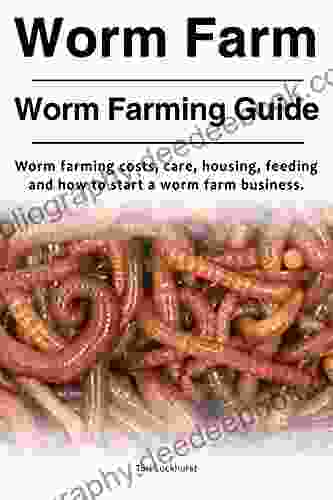The Ultimate Worm Farm Guide: Costs, Care, Feeding, Housing, and How to Run a Worm Farm

4.1 out of 5
| Language | : | English |
| File size | : | 1043 KB |
| Text-to-Speech | : | Enabled |
| Enhanced typesetting | : | Enabled |
| Lending | : | Enabled |
| Screen Reader | : | Supported |
| Print length | : | 113 pages |
Worm farming, also known as vermicomposting, is a sustainable and eco-friendly way to dispose of organic waste while creating nutrient-rich fertilizer for your garden. This beginner's guide provides comprehensive information on the costs, care, feeding, housing, and operation of a worm farm. Whether you're a seasoned gardener or just starting out, this guide will equip you with the knowledge and skills to establish a thriving worm farm in your backyard.
Chapter 1: Costs of a Worm Farm
The startup costs for a worm farm can vary depending on the size and type of setup you choose. Here's a breakdown of the essential components and approximate prices:
- Worm bin: $20-$100
- Worms: $20-$50 per pound (1,000-2,000 worms)
- Bedding: $5-$20 per cubic foot (shredded cardboard, straw, coconut coir)
- Compost starter: $10-$20 (optional but recommended to kickstart the composting process)
- Tools: $10-$50 (shovel, watering can, thermometer, pH meter)
The ongoing costs of maintaining a worm farm are minimal, primarily involving the purchase of additional bedding as needed and the occasional repair or replacement of equipment.
Chapter 2: Care and Maintenance of Worms
Red wigglers (Eisenia fetida) and tiger worms (Eisenia andrei) are the most commonly used composting worms due to their voracious appetite and tolerance of various conditions. Here are some essential care guidelines:
Temperature
Worms thrive in temperatures between 55°F and 80°F (13°C - 27°C). Extreme temperatures can cause worms to go dormant or even die.
Moisture
The bedding should be kept moist but not soggy. A good way to check the moisture level is to squeeze a handful of bedding. If water drips out, it's too wet; if it falls apart without crumbling, it's too dry.
pH Level
Worms prefer a pH level between 6.5 and 7.5. If the pH is too acidic or alkaline, it can harm the worms and slow down the decomposition process.
Aeration
Worms need oxygen to survive. Make sure the bedding is loose and well-aerated to prevent anaerobic conditions that can lead to odors and decomposition problems.
Food
Worms primarily feed on organic waste such as vegetable scraps, fruit peels, coffee grounds, and shredded paper. Avoid feeding them meat, dairy, or oily foods.
Chapter 3: Feeding and Harvesting Vermicompost
Feeding Your Worms
Provide your worms with a constant supply of organic waste, but avoid overloading them. Gradually add food as they consume it. Chop or shred large pieces to make them easier for worms to digest.
Harvesting Vermicompost
Vermicompost, also known as worm castings, is a nutrient-rich fertilizer that can be used to enhance plant growth and soil health. When your worm bin is full and the worms have processed most of the waste, it's time to harvest the vermicompost.
To harvest, remove the lid and top layer of bedding. Collect the dark, crumbly castings from the bottom of the bin. You can use a mesh sieve to separate the castings from any remaining worms or bedding.
Chapter 4: Housing Options for Worm Farms
There are several different types of worm bins available, each with its own advantages and disadvantages:
Indoor Worm Bins
Indoor worm bins are compact and convenient, making them suitable for apartments or small spaces. They are typically made of plastic or wood and have multiple trays or compartments for easy feeding and harvesting.
Outdoor Worm Bins
Outdoor worm bins are larger and more durable, ideal for larger-scale composting operations. They are usually made of wood or plastic and can be placed in the garden or on a patio.
Flow-Through Worm Bins
Flow-through worm bins are continuous composting systems that allow you to add new waste at the top and harvest finished castings at the bottom. They are designed for high-volume composting and require more maintenance than other types of bins.
Chapter 5: How to Run a Successful Worm Farm
Creating a Thriving Ecosystem
To ensure a healthy and productive worm farm, it's important to create a balanced ecosystem:
- Provide a diversity of organic waste.
- Maintain optimal moisture, temperature, and pH levels.
- Prevent overcrowding by adjusting the number of worms according to the size of your bin.
Troubleshooting Common Problems
Here are some common problems that can arise in worm farming and their potential solutions:
- Worms dying: Check temperature, moisture, pH, and aeration levels.
- Unpleasant odors: Overfeeding, too much moisture, or anaerobic conditions can cause odors. Aerate the bedding and adjust the feeding schedule.
- Worms escaping: Ensure the bin lid is secure and the bedding is not too dry or acidic.
- Worms not eating: Check the pH level and make sure the food is fresh and non-toxic.
Worm farming is a rewarding and sustainable practice that can benefit both your garden and the environment. By understanding the costs, care, feeding, housing, and operation of a worm farm, you can establish a thriving ecosystem in your backyard. Embrace the benefits of organic fertilizer, waste reduction, and the satisfaction of knowing that you're contributing to a sustainable future.
Image Alt Attributes
4.1 out of 5
| Language | : | English |
| File size | : | 1043 KB |
| Text-to-Speech | : | Enabled |
| Enhanced typesetting | : | Enabled |
| Lending | : | Enabled |
| Screen Reader | : | Supported |
| Print length | : | 113 pages |
Do you want to contribute by writing guest posts on this blog?
Please contact us and send us a resume of previous articles that you have written.
 Novel
Novel Page
Page Chapter
Chapter Text
Text Story
Story Genre
Genre Paperback
Paperback E-book
E-book Newspaper
Newspaper Paragraph
Paragraph Bookmark
Bookmark Bibliography
Bibliography Foreword
Foreword Preface
Preface Bestseller
Bestseller Narrative
Narrative Autobiography
Autobiography Memoir
Memoir Reference
Reference Dictionary
Dictionary Narrator
Narrator Character
Character Catalog
Catalog Card Catalog
Card Catalog Periodicals
Periodicals Study
Study Scholarly
Scholarly Lending
Lending Reserve
Reserve Reading Room
Reading Room Special Collections
Special Collections Interlibrary
Interlibrary Study Group
Study Group Dissertation
Dissertation Storytelling
Storytelling Awards
Awards Reading List
Reading List Book Club
Book Club Theory
Theory Textbooks
Textbooks J L Vampa
J L Vampa Lissa Price
Lissa Price Ann Quin
Ann Quin D C Stricklin
D C Stricklin Ann Southworth
Ann Southworth Diamond Rio
Diamond Rio Vikki Walton
Vikki Walton Billy Graham
Billy Graham William J Baumol
William J Baumol Desi Serna
Desi Serna Ralf Rothmann
Ralf Rothmann Cara Wall
Cara Wall Christophe Levaux
Christophe Levaux Anil Sethi
Anil Sethi Stephan P Kudyba
Stephan P Kudyba Anit Korpal
Anit Korpal G Education
G Education Gayle G Roper
Gayle G Roper Daniele Ganser
Daniele Ganser James Ernest Shaw
James Ernest Shaw
Light bulbAdvertise smarter! Our strategic ad space ensures maximum exposure. Reserve your spot today!

 Chuck MitchellUnveiling the Ultimate Archive: The Complete Comics Collection Stone Arch...
Chuck MitchellUnveiling the Ultimate Archive: The Complete Comics Collection Stone Arch...
 Orson Scott CardThe Big Book of Cello Songs: The Essential Collection of 100 Classical, Folk,...
Orson Scott CardThe Big Book of Cello Songs: The Essential Collection of 100 Classical, Folk,... Junichiro TanizakiFollow ·8.1k
Junichiro TanizakiFollow ·8.1k Javier BellFollow ·9.3k
Javier BellFollow ·9.3k Ian MitchellFollow ·5k
Ian MitchellFollow ·5k Greg CoxFollow ·6.4k
Greg CoxFollow ·6.4k Jason ReedFollow ·18.8k
Jason ReedFollow ·18.8k Jayson PowellFollow ·15.1k
Jayson PowellFollow ·15.1k Seth HayesFollow ·8.5k
Seth HayesFollow ·8.5k Beau CarterFollow ·4k
Beau CarterFollow ·4k

 Braden Ward
Braden WardFeminism's Forgotten Fight: The Ongoing Battle for...
The feminist movement has historically...

 Julio Cortázar
Julio CortázarBlue Heaven Black Night: A Literary Journey Through Love,...
In the realm of...

 Eddie Bell
Eddie BellA Journey Through Time: Exploring the Enchanting World of...
The vibrant tapestry of New...

 Lawrence Bell
Lawrence BellValiance Dragon Soul Press Anthology: A Literary Odyssey...
Step into a realm where...

 Aron Cox
Aron CoxEmbark on a Creative Odyssey with Jean Leinhauser's "101...
Unveil a Kaleidoscope of...
4.1 out of 5
| Language | : | English |
| File size | : | 1043 KB |
| Text-to-Speech | : | Enabled |
| Enhanced typesetting | : | Enabled |
| Lending | : | Enabled |
| Screen Reader | : | Supported |
| Print length | : | 113 pages |













